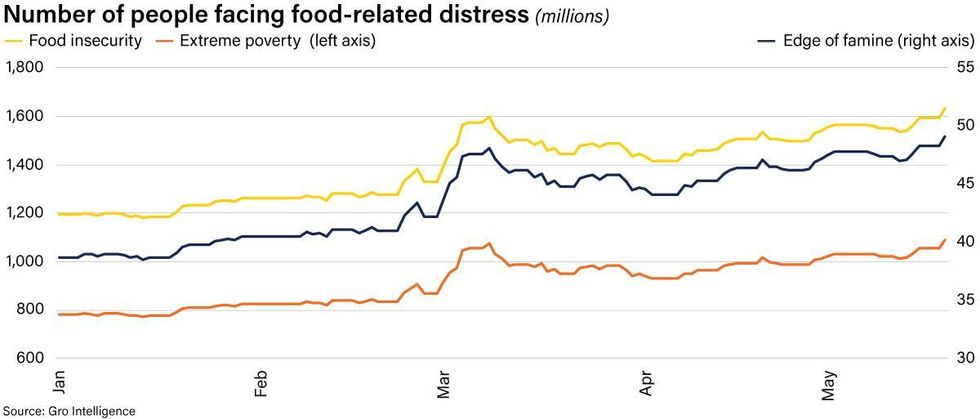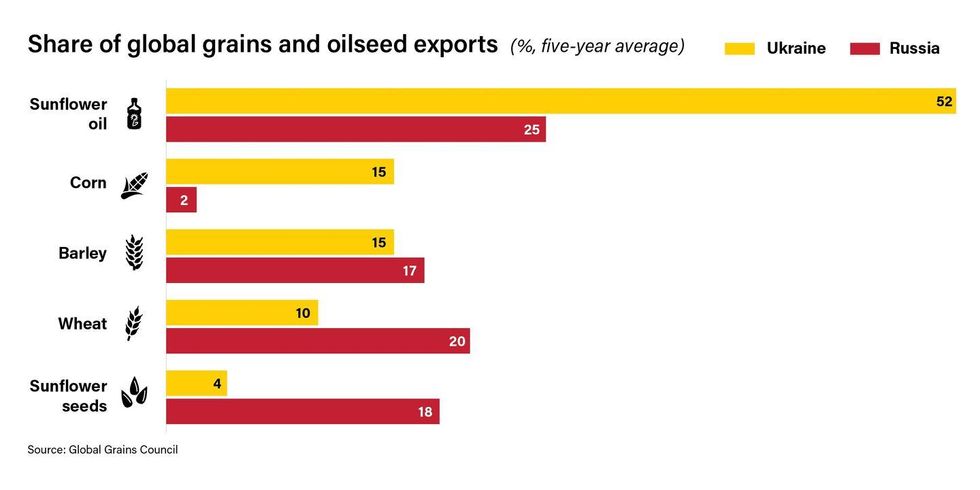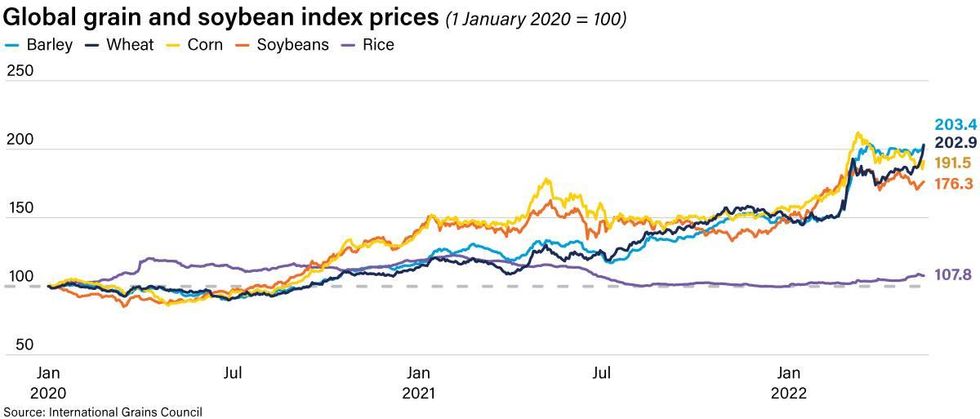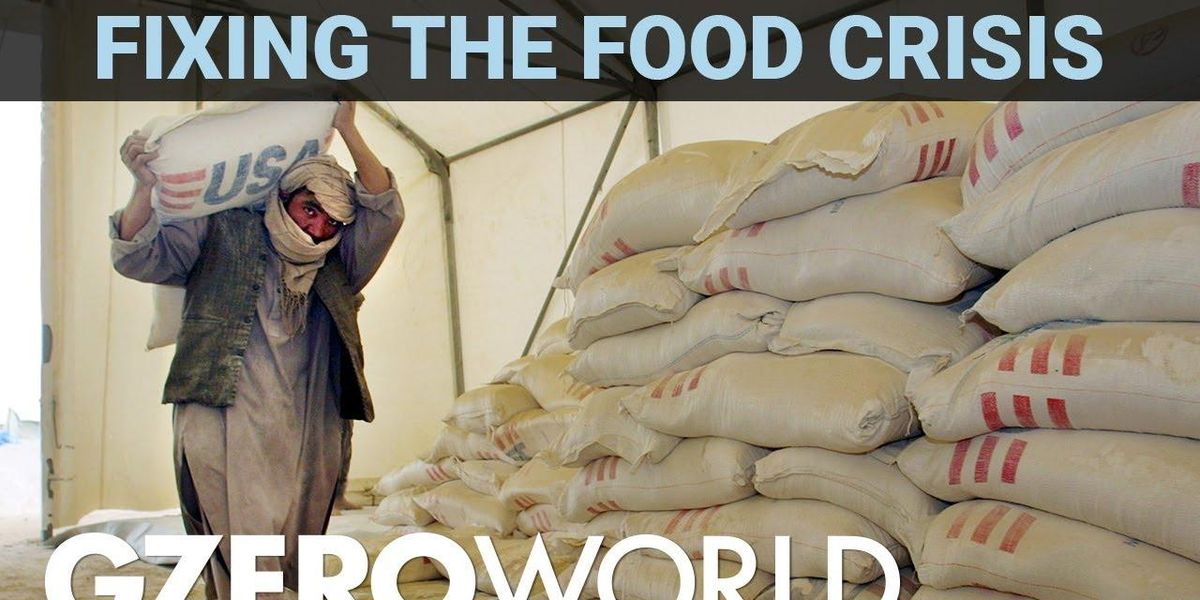Trending Now
We have updated our Privacy Policy and Terms of Use for Eurasia Group and its affiliates, including GZERO Media, to clarify the types of data we collect, how we collect it, how we use data and with whom we share data. By using our website you consent to our Terms and Conditions and Privacy Policy, including the transfer of your personal data to the United States from your country of residence, and our use of cookies described in our Cookie Policy.
{{ subpage.title }}
Food emergency: what to do when people are hungry now
On global issues, the international community must walk and chew gum at the same time. It needs to learn to deal with simultaneous crises that play off each other, says UN Foundation President Elizabeth Cousens.
That's why we dropped the ball on hunger.
Now the needs are huge and growing. We haven't seen a lot of images of starvation yet, but they are coming, Cousens tells Ian Bremmer on GZERO World.
"We have to be able to rise to this challenge, and see it as something that's in both our interest," she says, adding that “we have done heroic things before on the humanitarian front — it's not like we're not collectively capable."
Watch the GZERO World episode: Inequality isn't inevitable - if global communities cooperate
Podcast: Salvaging the world we leave our kids with innovative philanthropy
Listen: Global inequality has reached a level we haven’t seen in our lifetimes and recent geopolitical convulsions have only made things worse. The rich have gotten richer while extreme poverty has exploded. UN Foundation President Elizabeth Cousens thinks it's the perfect time for institutions backed by the 1% to step up. She speaks with Ian Bremmer on the GZERO World podcast about the key role that innovative philanthropy could play to address problems exacerbated by the war in Ukraine, economic fallout from the COVID pandemic, and a warming planet.
Why now? The stakes are so high and the crises so urgent that Cousens sees a window of opportunity for philanthropy to take swift action instead of their traditional long-term approach. When it comes to immediate and deadly problems like famine and flooding, an influx of money could start making a huge difference very quickly.
Subscribe to the GZERO World Podcast on Apple Podcasts, Spotify, Stitcher, or your preferred podcast platform, to receive new episodes as soon as they're published.- Is the world coming apart? Drama at Davos ›
- Global food crisis: when food isn't merely expensive ›
- In a food crisis, export controls are "worst possible" thing to do, says UN Foundation chief ›
- Podcast: The Ukraine war is crippling the world's food supply, says food security expert Ertharin Cousin ›
- Inequality isn't inevitable - if global communities cooperate - GZERO Media ›
- Philanthropy's moment to act - GZERO Media ›
War in Ukraine puts 280 million at risk of hunger
War in Ukraine puts 280 million at risk of hunger
The war in Ukraine has been dominating headlines since Russia’s unprovoked invasion on February 24. Of all the implications of the conflict, the most important is also one of the least well-covered: its impact on global food systems.
Three months in, the war has jolted agricultural markets, leading to soaring food prices and growing global hunger. The FAO’s Cereal Price Index was up 21% between January and April, while the Vegetable Oils Index was up 28% in the same period. Before the war started, there were nearly 1.2 billion people globally facing food insecurity, of which 780 million lived in extreme poverty and almost 39 million were at risk of famine. Fast forward to today, and the ranks of people facing food-related distress have swelled to 1.6 billion, 1.1 billion, and 49 million, respectively.
Want to understand the world a little better? Subscribe to GZERO Daily by Ian Bremmer for free and get new posts delivered to your inbox every week.
 Number of people facing food-related distressGro Intelligence
Number of people facing food-related distressGro Intelligence
This is a humanitarian disaster much larger than anything the world has experienced in modern times. And with no end in sight to the war in Ukraine, the crisis isn’t going away. In fact, it’s going to get worse.
According to a recent study conducted by Eurasia Group and DevryBV Sustainable Strategies, food insecurity will affect up to 1.9 billion people (nearly one-quarter of the world population) by November 2022. The report, titled Food Security and the Coming Storm,estimates that over the next five months the war will plunge more than 280 million people into food insecurity, 200 million into extreme poverty, and 7 million to the edge of famine.
Even before the war, record numbers of people around the world were facing food distress on the back of the Covid-19 pandemic, which disrupted global supply chains and led to high food and energy prices as well as rising poverty and hunger, and extreme weather events linked to climate change, which increasingly threaten agricultural yields in large swathes of the world’s cultivated lands. United Nations Secretary-General Antonio Guterres has warned that these converging crises are unleashing a “hurricane of hunger.”
Scenarios for the war and food distress
Looking ahead, how bad the food crisis gets will depend on what happens in the war between Russia and Ukraine. Eurasia Group, the political risk firm I lead, predicts that over the next three months, the war in Ukraine will devolve into a drawn-out, unstable stalemate with a 70% probability. This scenario entails continued low-level fighting in the south and east of Ukraine, with Russia capturing most of the Donbas and holding onto the land bridge linking it to Crimea, Western sanctions remaining in place, and no prospect of a negotiated settlement or a ceasefire.
We put the odds that the conflict escalates further at 25%, in which case Russia would resume its attacks on northern and western Ukraine as well as Kyiv, prompting a step-change intensification in Western sanctions. Finally, we assign a 5% probability to the prospect of a climbdown, with most of the fighting ending and negotiations eventually leading to at least some sanctions relief.
Based on these scenarios and their likely effects on food prices, the report estimates that over the next five months, the Russia-Ukraine war is very likely (95% odds) to push 142-283 million people globally into food insecurity, 103-201 million into extreme poverty, and 3.5-6.9 million to the edge of famine.
 Scenarios for the war and food distressEurasia Group, Gro Intelligence
Scenarios for the war and food distressEurasia Group, Gro Intelligence
The worst humanitarian outcome comes from Eurasia Group’s basecase scenario rather than from its worst-case scenario, as a stalemate would prolong the uncertainty and disruption for longer than a definite escalation.
In the unlikely scenario of a ceasefire in Ukraine, the number of people facing food insecurity would fall by only about 123 million, while those in extreme poverty and facing famine would drop by 95 million and 2.7 million, respectively. This is evidence of just how much food distress is already baked in due to pandemic-related disruptions, climate change, and other factors unrelated to the Russia-Ukraine war.
Transmission channels
There are several ways in which the Russia-Ukraine war disrupts global food security.
First, through reduced food exports from Russia and Ukraine, which before the war jointly contributed 30% of global wheat exports, 32% of barley exports, 17% of corn exports, and nearly 80% of sunflower oil exports. Together, these two countries alone supply 12% of the world’s traded calories.
 Share of global Grains and Oilseed ExportsGlobal Grains Council
Share of global Grains and Oilseed ExportsGlobal Grains Council
Fighting in eastern and southern Ukraine has severely damaged Ukraine’s agricultural production capacity, and the Russian navy’s blockade of Ukraine’s Black Sea ports prevents the export of most of the foodstuffs Ukraine is able to produce, anyway. David Beasley, the head of the UN World Food Program, described Russia’s blockade as an open “declaration of war” on global food security. Meanwhile, Western sanctions and Russian countersanctions inhibit food and fertilizer exports from Russia and Belarus, and hoarding and preemptive protectionist measures such as export restrictions by some food producers (notably, India is curtailing wheat and sugar exports, and Indonesia has banned palm oil shipments) further exacerbate the supply crunch and put upward pressure on prices.
Second, through reduced fertilizer exports from Russia and Belarus, two of the world’s largest fertilizer exporters. Fertilizer is a key precursor for half of the food consumed in the world, especially for wheat, rice, and corn—the latter of which is also a critical input for dairy and meat production. Global fertilizer prices have risen by more than 230% since the pandemic started—in part because of record-high natural gas prices (a key input for some fertilizers), rising global demand, and Chinese export restrictions, and in part because of Western sanctions on Russian and Belarusian exports.
Third, through higher energy prices, which raise food (and fertilizer) production and transportation costs that are then passed onto consumers in the form of higher food prices. Russia is a major oil and gas exporter, especially to Europe which is still highly dependent on Russian energy imports. As European governments move to ban Russian oil imports and consider cutting off Russian gas and imposing secondary sanctions, energy as an input in the food supply chain in Europe and elsewhere will become even scarcer and more expensive in the medium term. Reduced energy availability and higher prices will also ripple out to food producers in other regions.
And fourth, through higher transportation costs, on the back of global shipping conditions already strained by the pandemic and now further complicated by the Russian blockade of Ukraine’s ports, a shortage of shipping crews, and safety issues in the Black Sea region due to Ukrainian and Russian underwater mines. While Western sanctions technically exempt food trade, most logistics and shipping companies either are charging exorbitant rates to carry Russian food products (passing through high freight insurance premiums) or are “self-sanctioning” to avoid Russian, Belarusian, and Ukrainian cargoes altogether.
Implications
In Eurasia Group’s basecase of an unstable stalemate, continued fighting will degrade Ukrainian infrastructure and prevent planting and harvesting in southern and eastern Ukraine, Russia will keep blockading Black Sea shipping routes, Western sanctions will continue to block Russian and Belarusian fertilizer exports (lowering agricultural yields), energy prices will remain elevated, and food prices will rise further as “markets suffer the cascading effects of prolonged uncertainty, logistical and supply constraints.”
 Global grain and soybean index pricesInternational Grains Council
Global grain and soybean index pricesInternational Grains Council
The resulting crisis will leave no country unscathed. Not surprisingly, it is the poorest and most vulnerable countries that will be hardest hit—especially those that are net food importers, have large populations of urban poor, and are already saddled with high debt burdens. That includes much of the Middle East and North Africa, which in recent years received about half of Ukraine’s total wheat exports, as well as Indonesia, Sri Lanka, Pakistan, India, Central America, and the Dominican Republic.
Beyond the humanitarian fallout of the global food crunch and higher prices brought on by the Russian invasion of Ukraine, the political ramifications are also dire, with an elevated risk of social unrest, mass migration, and general instability. Low- and middle-income countries will face the most disruption. We’re already seeing this unfold in Pakistan, Sri Lanka, and Peru, where soaring food inflation has sparked violent protests and toppled governments.
The outsized impact of the global food crisis on the most vulnerable countries is one reason why I’ve been saying and writing that the war in Ukraine merits more attention than the conflicts in Syria, Yemen, and Afghanistan—not because Ukrainian lives are worth more than Syrian, Yemeni, and Afghan lives, but because the collateral damage for the world’s poorest is orders of magnitude greater.
It also helps explain why there’s a growing divide between the West and developing countries on how to respond to Russia’s aggression. While Russia is morally responsible for the global food crisis—having invaded Ukraine without provocation—many in the developing world see Western sanctions as being equally (or more) to blame for their hunger pains. As Ertharin Cousin, former head of the UN World Food Programme, told me in an interview for GZERO World, this puts the international community in a bit of a bind: either sanction Russia at the expense of increased hunger in poor countries, or let Russia profit from selling food to the world even as it continues to attack Ukraine.
While the Eurasia Group report lays out a number of policies that could alleviate the crisis and minimize its human toll, most would require a degree of international cooperation that is hard to imagine in our G-Zero world. However devastating it is for its victims, a problem like hunger that affects mostly disenfranchised people in developing countries is not existential enough for the most powerful global actors to pay attention—or to put aside their differences to solve it. That’s why this is not a "goldilocks crisis" of the kind I describe in my latest book, The Power of Crisis.
Of course, the easiest way to end the global food crisis would be for Russia to stop its war of aggression against Ukraine. But that’s unlikely to happen anytime soon. While there have been some negotiations about creating a humanitarian corridor allowing safe passage of ships carrying food through the Black Sea, Russia’s demand for sanctions relief in return makes a breakthrough unlikely.
🔔 And if you haven't already, don't forget to subscribe to my free newsletter, GZERO Daily by Ian Bremmer, to get new posts delivered to your inbox.
What happened at Davos
The tiny alpine village of Davos in Switzerland used to be the place to be for some of the world's most powerful people to talk about very important stuff at the annual World Economic Forum.
Indeed, the name “Davos” had become code for a globalist agenda that promotes things like liberal democracy and encourages cooperation on big issues such as climate change to fix the world's problems.
For a long time, it worked. People became more connected, and poverty declined. But not anymore, Ian Bremmer explains on GZERO World.
When titans of industry and government gathered last week in Davos, faith in the WEF's global agenda had taken a hit due to the economic wreckage of the pandemic and more recently Russia invading Ukraine.
Only three months in, the war has already left a wake of destruction that'll take many billions of dollars and years to rebuild.
And its ripple effects are hurting everyone via skyrocketing energy prices and food inflation that'll cause hunger in many parts of the world.
Still, there were some reasons for optimism, like support for Ukraine or a more unified West. But there are many pitfalls along the way.
Danger to the acutely hungry: lack of access, or lack of money
Where will the war make most people go hungry?
The pandemic pushed some 275 million people into acute hunger around the world. How many more will struggle to find their next meal due to the war in Ukraine?
About double that amount, estimates Ertharin Cousin, former head of the UN World Food Programme.
She tells Ian Bremmer that conflict-affected countries are especially vulnerable because their populations depend on the WFP's ability to provide food assistance, but not the only ones in deep trouble.
In low-income nations like Bangladesh, Burkina Faso, Guatemala, Haiti or Mali, people will also go hungry as prices rise because governments can't afford to subsidize food.
"As a result," Cousin explains, "you'd have more people slipping into a position where food is maybe available, but inaccessible because they cannot afford it."
Watch the GZERO World episode: A perfect storm of food insecurity: a problem for all of us
Russia's war in Ukraine is starving the world
Ukraine is an agricultural powerhouse. But so is Russia. Between the two they account for almost a third of the world's wheat exports.
The Russian invasion has disrupted planting and harvesting in Ukraine. Sanctions against Moscow, for their part, have restricted shipping — further limiting food supplies.
Who's most at risk? Countries in the Middle East and North Africa that depend on these grain imports, like Egypt.
All this comes as the world was already experiencing record-high food prices due to COVID-related supply chain problems and climate change.
The UN estimates that the disruption to food systems causes by the war will make up to 47 million people go hungry.
Watch the GZERO World episode: A perfect storm of food insecurity: a problem for all of us
- A perfect storm of food insecurity: a problem for all of us - GZERO ... ›
- War of the Sunflower Superpowers - GZERO Media ›
- Will Putin eat the world's bread? - GZERO Media ›
- Food security: one area where Putin's plans are bearing fruit ... ›
- Russia plays hardball with blockage of Ukraine grain exports - GZERO Media ›
- Russia weaponizing blockage of Ukraine grain exports - GZERO Media ›
- Russia's weapon: blocking Ukraine grain exports - GZERO Media ›
- How Putin’s war increased theft of car parts - GZERO Media ›
Conundrum: Russian food can prevent starvation by the world's poor
Russia's war in Ukraine has put the international community in a tough spot.
Sanctions against Russia that affect global food commodities will make people go hungry, especially in the Global South. But then the Russians will continue to profit from selling all that food.
So, who should make that call? Ertharin Cousin, who knows a thing or two about the United Nations because she used to run its World Food Programme, says it's time for the UN Security Council to step in.
But there's a divide between Western powers that want to be tough on Russia yet keep buying their oil & natural gas, & non-aligned countries in Global South that rely on Russia's food & can't pay to subsidize staples.
Cousin tells Ian Bremmer the West should "move beyond platitudes" and offer developing countries financial support to deal with the food crisis because now with China, "we need to realize we're not the only game in town."
Watch the GZERO World episode: A perfect storm of food insecurity: a problem for all of us
- A perfect storm of food insecurity: a problem for all of us - GZERO ... ›
- The Graphic Truth: Piling sanctions on Russia - GZERO Media ›
- Russian ruble weathers sanctions storm - GZERO Media ›
- Why is Russia on the UN Security Council? - GZERO Media ›
- Why is Russia on the UN Security Council? - GZERO Media ›
- Why is Russia on the UN Security Council? - GZERO Media ›
A perfect storm of food insecurity: a problem for all of us
Russia and Ukraine are agricultural powerhouses. But the war and sanctions have crippled their ability to feed the world.
Who's most at risk? Developing countries that rely on those imports. What will the impact be? The disruptions could double the number of people currently suffering from acute food insecurity (some 275 million) due to the pandemic.
On GZERO World, Ian Bremmer speaks to Ertharin Cousin, who knows a thing or two about food security as the former executive director of the UN World Food Programme
Cousin says the war has created a perfect storm that'll led to a global food price and supply crisis. Everyone will be affected because we're talking about global commodities, and the worst might be yet to come since agriculture is a seasonal business.The conflict, she says, has put the international community in a tough spot. Sanctions will cause hunger, but otherwise, Russia will continue to profit from selling food to the world.
And there's a growing divide between the West and non-aligned developing countries that can't afford to not import Russian food. Conflict-affected nations are the most vulnerable, but many low-income nations will also struggle because they can't afford subsidies to feed their people.
As a bonus, battle over borscht! What’s the back story, and why is the soup such an important part of Ukraine’s national identity? We spoke with a chef, a historian, and a Ukrainian emigré couple to learn more.





